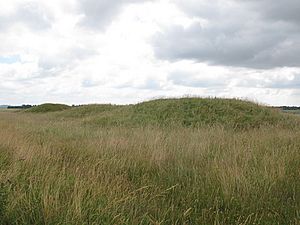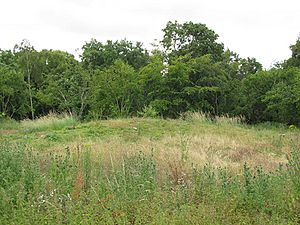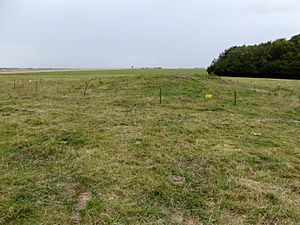Cursus Barrows facts for kids

View west from the top of Amesbury 43, looking at the Amesbury 44 and 45 barrows
|
|
|
Map showing the Cursus Barrows within the Stonehenge section of the Stonehenge and Avebury World Heritage Site
|
|
| Alternative name | Cursus round barrow cemetery |
|---|---|
| Region | Wiltshire |
| Coordinates | 51°11′00″N 1°50′14″W / 51.1832°N 1.8372°W |
| Type | Round barrow cemetery |
| History | |
| Periods | Neolithic / Bronze Age |
| Site notes | |
| Public access | Yes |
| Designated | 1986 |
| Reference no. | 373 |
The Cursus Barrows is a special burial ground from the Stone Age and Bronze Age. It's located mostly south of the western end of the Stonehenge Cursus. This ancient cemetery has about 18 round barrows. These are scattered along a ridge that runs from east to west. Some of these old mounds are hard to see today. You can find the Cursus Barrows just north of the path between the Stonehenge Visitor Centre and Stonehenge.
Contents
- Exploring the Cursus Barrows
- Amesbury 43 and 44: Bell Barrows
- Amesbury 45, 46, 47 and 48: More Ancient Mounds
- Amesbury 49, 50 and 51: Hidden Discoveries
- Amesbury 52, 53, 54 and 112: Barrows in Fargo Plantation
- Fargo Hengiform: A Small Enclosure
- Monarch of the Plain (Amesbury 55): A Giant Barrow
- Amesbury 56 and Winterbourne Stoke 30: Western Barrows
- Winterbourne Stoke 28 and 29: Lost to History
Exploring the Cursus Barrows
This ancient burial ground stretches for 1200 metres (about three-quarters of a mile) from east to west. It is also 250 metres (about a quarter of a mile) wide. It includes round barrows known as Amesbury 43 to 56, and Winterbourne Stoke 28 to 30. There's also a special site called the Fargo hengiform. Many of these barrows were dug up by Richard Colt Hoare in the early 1800s.
Amesbury 43 and 44: Bell Barrows
Amesbury 43 and 44 are two interesting barrows. They are part of the eastern side of the Cursus barrow cemetery.
Amesbury 43: A Large Bell Barrow
Amesbury 43 is a type of barrow called a bell barrow. It has a circular mound in the middle, which is 3.4 metres (about 11 feet) high and 25 metres (about 82 feet) wide. This mound sits on a flat base and has a circular ditch around it. The whole monument is about 60 metres (about 197 feet) across. William Stukeley dug here in 1723, but didn't find much. Parts of the barrow were damaged when a road was built in the 1700s.
Amesbury 44: A Twin Bell Barrow
Amesbury 44 is unique because it has two barrow mounds. Both are surrounded by a single ditch. The eastern mound is 1.6 metres (about 5 feet) high and 15 metres (about 49 feet) wide. The western mound is taller, at 2.3 metres (about 7.5 feet) high and 17 metres (about 56 feet) wide. The ditch around them is 5 metres (about 16 feet) wide and 1 metre (about 3 feet) deep. Stukeley also dug into both mounds in 1723. The western mound was dug again by William Cunnington in 1803. Inside the eastern mound, they found ashes from a cremation in a pot, along with bronze, amber, and shale items. The western mound held a burial and another cremation in a stone box called a cist.
Amesbury 45, 46, 47 and 48: More Ancient Mounds
Amesbury 45: A Tall Bell Barrow
Amesbury 45 is another large bell barrow with a ditch. It still stands 3.5 metres (about 11.5 feet) high. The whole monument is about 56 metres (about 184 feet) wide. Its central mound is 26 metres (about 85 feet) wide. Colt Hoare dug here in the early 1800s. He found ashes from a cremation near a stone box with burnt bones.
Amesbury 46 and 47: Linked Bell Barrows
Amesbury 46 and 47 are a pair of bell barrows. They are 38 metres (about 125 feet) and 36 metres (about 118 feet) wide overall. Their central mounds are each 20 metres (about 66 feet) wide and almost 2 metres (about 6.5 feet) high. These barrows are lined up east to west, and their ditches connect. Colt Hoare dug into Amesbury 46 and found burned bones with a small spearhead. In Amesbury 47, his digs revealed a simple burial of burned bones.
Amesbury 48: A Bowl Barrow with Treasures
Amesbury 48 is a bowl barrow, which is a simpler type of mound. It's now only 0.3 metres (about 1 foot) high. It also has an outer bank, which is a slight rise 4 metres (about 13 feet) wide and 0.2 metres (about 0.6 feet) high. Colt Hoare's excavations here found a cremation with beads made of stone, amber, and faience (a type of glazed pottery).
Amesbury 49, 50 and 51: Hidden Discoveries
Amesbury 49: A Damaged Barrow
Amesbury 49 is a round barrow or bowl barrow that is now mostly flat. It was about 26 metres (about 85 feet) wide. Colt Hoare dug here in the early 1800s but didn't find anything. In 1913, it was in good shape, but farming in the mid-1900s damaged it badly.
Amesbury 50: The "Second Henge" Discovery
Amesbury 50 is a bowl barrow that is also mostly flat now. It has a central oval mound about 0.5 metres (about 1.6 feet) high and 20 metres (about 66 feet) wide. It's surrounded by two ditches with openings to the southwest and northeast. Colt Hoare dug here without finding much. Farming also damaged this barrow in the mid-1900s.
In 2010, the Stonehenge Hidden Landscapes project made an exciting discovery here. Using special tools like ground-penetrating radar (which sees underground) and magnetometers (which detect changes in the Earth's magnetic field), they found a "henge-like" monument. This discovery suggested that the large circular ditch was dug in sections. They also found signs of 24 pits, each one metre wide, inside the ditch. These pits might have held a wooden structure. The two entrances, like at Stonehenge, suggested a similar design. Some thought the central burial mound might have been built later. News reports in 2010 called this a "second henge" or Stonehenge's "twin." However, other archaeologists thought it might just be a very unusual Bronze Age barrow.
Amesbury 51: A Rebuilt Barrow
Amesbury 51 is a bell or bowl barrow that has been rebuilt. It's about 36 metres (about 118 feet) wide. Colt Hoare's digs found a main burial with a beaker (a type of pot) and two other burials. It was dug again in 1960. They found old leather, a burial under a wooden board, and a long-necked beaker with other tools. This was thought to be a possible mortuary house (a place for preparing the dead). The ditch around it was also found to be dug in sections. Small pieces of bluestone (the same stone used at Stonehenge) were found in the ditch. This barrow was also damaged by farming but was rebuilt in 1960 to its current height of 1.5 metres (about 5 feet).
Amesbury 52, 53, 54 and 112: Barrows in Fargo Plantation
Amesbury 52 is a round barrow just east of the Fargo plantation. It is 0.7 metres (about 2 feet) high and 25 metres (about 82 feet) wide. Amesbury 53 and Amesbury 54 are inside the Fargo plantation. When Amesbury 54 was dug in the early 1800s, it revealed a main burial with a beaker, a flint spearhead, and a polished hammerhead. Amesbury 112 is on the southern edge of Fargo Plantation. It might be a disc barrow (a flat, circular area with a central mound). This site was likely flattened by the early 1800s and later had trees planted on it.
Fargo Hengiform: A Small Enclosure
The Fargo Hengiform is a small, special enclosure inside the Fargo Plantation. It's an uneven hollow about 8.5 metres (about 28 feet) wide. Digs in 1938 found a small oval ditch with an outer bank. This bank had gaps (causeways) on the north and south sides. In the middle, there was a grave with a skeleton, a beaker, a food vessel, and two cremations. Another cremation was found near the inside edge of the ditch.
Monarch of the Plain (Amesbury 55): A Giant Barrow
The Monarch of the Plain is a very large Bronze Age bell barrow on the western edge of the Fargo plantation. It is 2.8 metres (about 9 feet) high and up to 58 metres (about 190 feet) wide. Colt Hoare's excavation in the early 1800s only found charred wood.
Amesbury 56 and Winterbourne Stoke 30: Western Barrows
Amesbury 56 and Winterbourne Stoke 30 are two barrows at the western end of the Cursus. Amesbury 56 is a bowl barrow, or possibly a bell barrow. It is about 1.5 metres (about 5 feet) high and 25 metres (about 82 feet) wide. Colt Hoare dug here and found burials and grave goods, including a bronze dagger. Winterbourne Stoke 30 has been completely flattened and can no longer be seen. Colt Hoare also dug here and found what might have been a cremation. Winterbourne Stoke 30 was dug again in 1958. This showed it was a bell barrow with a central cremation pit. Burials of two children were also found in the barrow's ditch.
Winterbourne Stoke 28 and 29: Lost to History
Winterbourne Stoke 28 and 29 are two bowl barrows west of the Fargo plantation that are mostly destroyed. Colt Hoare dug into both. In Winterbourne Stoke 28, he found a bronze awl (a pointed tool) with a handle and a collared urn (a type of pot). During World War I, a military base was built over this area, destroying both barrows. Some small earthworks from Winterbourne Stoke 28 are said to still be visible.





